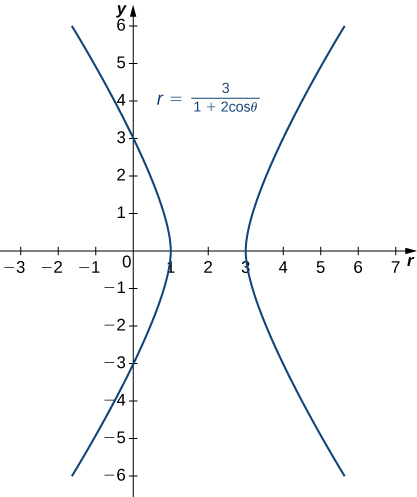| << Chapter < Page | Chapter >> Page > |
Determine the eccentricity of the hyperbola described by the equation
Sometimes it is useful to write or identify the equation of a conic section in polar form. To do this, we need the concept of the focal parameter. The focal parameter of a conic section p is defined as the distance from a focus to the nearest directrix. The following table gives the focal parameters for the different types of conics, where a is the length of the semi-major axis (i.e., half the length of the major axis), c is the distance from the origin to the focus, and e is the eccentricity. In the case of a parabola, a represents the distance from the vertex to the focus.
| Conic | e | p |
|---|---|---|
| Ellipse | ||
| Parabola | ||
| Hyperbola |
Using the definitions of the focal parameter and eccentricity of the conic section, we can derive an equation for any conic section in polar coordinates. In particular, we assume that one of the foci of a given conic section lies at the pole. Then using the definition of the various conic sections in terms of distances, it is possible to prove the following theorem.
The polar equation of a conic section with focal parameter p is given by
In the equation on the left, the major axis of the conic section is horizontal, and in the equation on the right, the major axis is vertical. To work with a conic section written in polar form, first make the constant term in the denominator equal to 1. This can be done by dividing both the numerator and the denominator of the fraction by the constant that appears in front of the plus or minus in the denominator. Then the coefficient of the sine or cosine in the denominator is the eccentricity. This value identifies the conic. If cosine appears in the denominator, then the conic is horizontal. If sine appears, then the conic is vertical. If both appear then the axes are rotated. The center of the conic is not necessarily at the origin. The center is at the origin only if the conic is a circle (i.e.,
Identify and create a graph of the conic section described by the equation
The constant term in the denominator is 1, so the eccentricity of the conic is 2. This is a hyperbola. The focal parameter p can be calculated by using the equation Since this gives The cosine function appears in the denominator, so the hyperbola is horizontal. Pick a few values for and create a table of values. Then we can graph the hyperbola ( [link] ).
| 0 | 1 | −3 | |
| 3 | 3 | ||

Identify and create a graph of the conic section described by the equation
Here
and
This conic section is an ellipse.

A general equation of degree two can be written in the form
The graph of an equation of this form is a conic section. If then the coordinate axes are rotated. To identify the conic section, we use the discriminant of the conic section One of the following cases must be true:

Notification Switch
Would you like to follow the 'Calculus volume 2' conversation and receive update notifications?